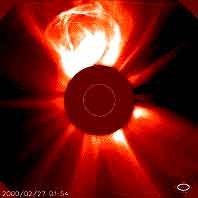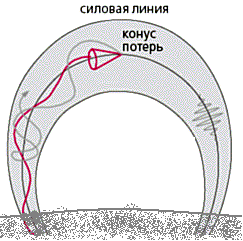The sun is simple. Part Three: About Solar Flares
In the third part of my story, we will focus on solar flares. I will tell you how they are formed and in general what it is.
As an example of the image obtained by us, I would like to cite the image of the Sun obtained with the TRACE telescope. The white box indicates the approximate size of the Earth.

The previous parts are here and here .
So what is a solar flare? A solar flare is a process of powerful energy release near the surface of the sun. This grandiose natural phenomenon is accompanied by the emission of large flows of charged particles of various energies and powerful wave processes. The flash manifests itself in all ranges of the electromagnetic spectrum - from gamma radiation to kilometer-long radio waves. In X-rays and radio beams, the brilliance and flux of radiation from a flare can be many orders of magnitude greater than the brightness and flux of radiation from the entire Sun.
During periods of a maximum of the 11-year cycle of solar activity, outbreaks occur almost daily. However, weak flashes are most often observed. Outbreaks of average power, from which significant consequences can be expected near the Earth, are quite rare - of the order of one per week. During periods of a minimum of an 11-year cycle, no outbreaks can be recorded for several months.
The outbreak is a very complex phenomenon and quite often consists of a large number of short-term (t <1c) energy releases in areas with significantly smaller sizes (d <1 thousand km). As a rule, powerful flashes occur in magnetic fields of complex configuration, formed from a combination of coronal magnetic loops based on sunspots or pores. The concentration of ions and electrons inside the flare loops varies from 109 to 1012 cm-3. The magnitude of the magnetic field in flare coronal loops is usually from 50 to 700 G. The temperature of the hot flash plasma reaches (2-5) * 107K.

Bright areas - active areas (AO) with a greatly increased magnetic field

Image from SOHO satellite, The sun is closed by a hood
How does the flash develop? As an example, I want to show one entertaining video of no less entertaining flash. occurred in the sun on August 22, 2005. The video was obtained from static pictures with an interval of 0.1 s.
It is seen that at first the bases begin to glow, and then the main "glow" goes to the top and then fades away. This happens due to the fact that the active emitting electrons from the bowels of the sun enter the flare loop, then move to the apex and then, losing energy, fall out of the loop. I will explain it schematically :) The

particle moves in a spiral, reflected from the ends of the loop. If the angle is insufficient, then the particle falls out of the resulting magnetic trap (colored line in the diagram). As a result, most of the active electrons accumulate over time at the apex of the loop and from there it spills back into the Sun.
As always, a small Wiki:
1. Magnetic trap - a magnetic field configuration that can hold charged particles inside of itself.
2. Active areas - areas with a high magnetic field, flashes arise in them.
What to read on the topic:
1. V.F. Melnikov "The mysteries of sunny weather"
2. S.A. Kaplan “Entertaining Radio Astronomy”
PS This is a rather small article. In the next I’ll try to tell about our observations and what we actually did on the example of one of the flashes. I will also touch on the software that we use
UPD.
As an example of the image obtained by us, I would like to cite the image of the Sun obtained with the TRACE telescope. The white box indicates the approximate size of the Earth.

The previous parts are here and here .
So what is a solar flare? A solar flare is a process of powerful energy release near the surface of the sun. This grandiose natural phenomenon is accompanied by the emission of large flows of charged particles of various energies and powerful wave processes. The flash manifests itself in all ranges of the electromagnetic spectrum - from gamma radiation to kilometer-long radio waves. In X-rays and radio beams, the brilliance and flux of radiation from a flare can be many orders of magnitude greater than the brightness and flux of radiation from the entire Sun.
During periods of a maximum of the 11-year cycle of solar activity, outbreaks occur almost daily. However, weak flashes are most often observed. Outbreaks of average power, from which significant consequences can be expected near the Earth, are quite rare - of the order of one per week. During periods of a minimum of an 11-year cycle, no outbreaks can be recorded for several months.
The outbreak is a very complex phenomenon and quite often consists of a large number of short-term (t <1c) energy releases in areas with significantly smaller sizes (d <1 thousand km). As a rule, powerful flashes occur in magnetic fields of complex configuration, formed from a combination of coronal magnetic loops based on sunspots or pores. The concentration of ions and electrons inside the flare loops varies from 109 to 1012 cm-3. The magnitude of the magnetic field in flare coronal loops is usually from 50 to 700 G. The temperature of the hot flash plasma reaches (2-5) * 107K.

Bright areas - active areas (AO) with a greatly increased magnetic field

Image from SOHO satellite, The sun is closed by a hood
How does the flash develop? As an example, I want to show one entertaining video of no less entertaining flash. occurred in the sun on August 22, 2005. The video was obtained from static pictures with an interval of 0.1 s.
It is seen that at first the bases begin to glow, and then the main "glow" goes to the top and then fades away. This happens due to the fact that the active emitting electrons from the bowels of the sun enter the flare loop, then move to the apex and then, losing energy, fall out of the loop. I will explain it schematically :) The

particle moves in a spiral, reflected from the ends of the loop. If the angle is insufficient, then the particle falls out of the resulting magnetic trap (colored line in the diagram). As a result, most of the active electrons accumulate over time at the apex of the loop and from there it spills back into the Sun.
As always, a small Wiki:
1. Magnetic trap - a magnetic field configuration that can hold charged particles inside of itself.
2. Active areas - areas with a high magnetic field, flashes arise in them.
What to read on the topic:
1. V.F. Melnikov "The mysteries of sunny weather"
2. S.A. Kaplan “Entertaining Radio Astronomy”
PS This is a rather small article. In the next I’ll try to tell about our observations and what we actually did on the example of one of the flashes. I will also touch on the software that we use
UPD.
